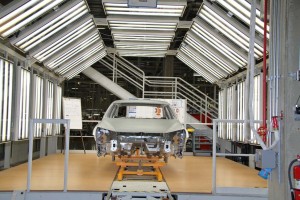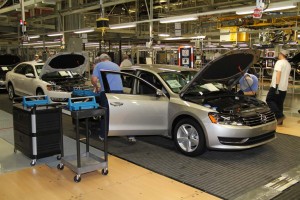If some of the early construction crews were a little nervous when work began on the new Volkswagen plant in Chattanooga, three years ago, they had a good reason. In an irony not lost on members of the team overseeing the project, the mounds dotting the abandoned site had once housed World War II – era bunkers where the U.S. military stored bombs that would eventually be dropped all over Germany – perhaps on the VW plant in Wolfsburg, in fact.
To everyone’s good fortune, the bunkers proved empty. And the fact is, these days, relations are a lot friendlier between the two countries. But the sprawling facility is still on a war footing of sorts.
After years of dithering over its role in the U.S. market, Volkswagen has made a commitment to more than double its sales by 2018, to at least 800,000 vehicles annually. Meanwhile, it hopes to bump its worldwide volumes to more than 8 million, Volkswagen AG CEO Martin Winterkorn declaring, the company “continues to have its sights firmly set on capturing pole position in the automotive industry.”
Chattanooga will play a critical role in meeting that goal – and that means that the plant that formally opened in the Southern heartland, last month, could very well undergo a significant expansion in the very near future. Indeed, TheDetroitBureau.com has learned, capacity could readily more than triple, according to a senior manager, “if it were appropriate.”

Aiming to overcome past quality problems, VW's new plant focuses heavily on inspection stations, like this one, to reveal any manufacturing issue.
The facility is the centerpiece of a billion-dollar investment in the new 2012 VW Passat. The sedan now rolling off the Chattanooga assembly line shares not only the name but many of the same underpinnings of the Passat sold elsewhere in the world. But, among other changes, it is decidedly larger than the European sedan introduced at the Paris Motor Show last September.
(For TheDetroitBureau.com’s review of the new 2012 Volkswagen Passat, Click Here.)
The car is also decidedly less expensive than the prior-generation Passat sold in the U.S. The base model saw a nearly $7,000 price drop, a move that Serban Boldea, the product planner known to colleagues as Dr. Passat, says is critical to broadening the nameplate’s appeal in the price-sensitive U.S. market.
“It is a critical part of the process of fixing the product,” he explained from a conference room alongside the new assembly line.
To get there, VW has built a highly-automated facility that is eventually expected to rival the best of its American-based competitors, factories like the new Toyota plant in Tupelo, Mississippi, the Kia plant in West Point, Georgia, and some of the recently updated Big Three factories in the Midwest.
Meanwhile, the maker has signed on its first 1,800 line workers at a labor rate that is more in keeping with some third-world factories. Tennessee employees are being paid just $14.50 an hour, with benefits bringing that to $27. That’s about half what Detroit and most of the Japanese-owned plants are currently paying. VW plans to increase wages slightly over the next three years, but expects to maintain a significant cost advantage.
The facility is as modern as one can expect, with 384 robots in the body shop alone, but a tour of the plant might startle some observers not used to the sound of hammers and hacksaws. VW managers are well aware of the company’s long-standing problems with Consumer Reports and J.D. Power, those well-respected third-party arbiters routinely placing most of the maker’s products in the lower tier when it comes to quality.
While Frank Fischer, the head of U.S. manufacturing, concedes “You can’t inspect quality into a vehicle,” the plant has an unusual number of stations where workers routinely pull products off the line and literally hammer them apart hoping to find any potential flaws, such as improper welds. Any defects are used to revise operations on the line.
To further ensure quality, the plant is scheduled to ramp up at an unusually slow pace – indeed, the first prototypes were being hand-built at the factory more than a year before its official opening.
But the pace is clearly quickening, and if all goes well, Chattanooga will soon be rolling out as many as 150,000 vehicles annually. Officially, the facility is dedicated to the Passat, but Fischer acknowledges the plant was designed with tremendous flexibility. That means it could “definitely, definitely” produce a wide range of products, perhaps the smaller Jetta, possibly even a bigger SUV like the VW Touareg.
Certainly, with exchange rates favoring dollar-based plants, that could mean a significant boost to the Volkswagen bottom line.
The plant, as it now stands, covers only a small portion of the old military site. It was designed specifically to allow for expansion, Fischer noting, “We could extend it to 250,000 (vehicles) a year” readily easily. That would require the addition of a new paint line, among other things, and VW might, at that point, consider adding a stamping plant – body panels currently being shipped to Chattanooga from several suppliers around the Southeast.
Even that number, however, wouldn’t be the limit to growth, Fisher confiding there’s enough room to mirror the existing plant, which could provide enough room to boost capacity “to 500,000 units, if it were appropriate.”
During a visit to Chattanooga last month, Winterkorn said VWAG is looking at the long-discussed possibility of adding an Audi plant in the U.S., now that this brand is also gaining traction. Audi of America topped the 100,000 mark for the first time and is looking to double that volume by 2018.
With the current weakness of the dollar, switching to a U.S. production base would help it improve competitiveness against makers like BMW and Mercedes-Benz, as well as Lexus, which already produce a number of models in the U.S.
Winterkorn suggested a decision on the Audi plant will come within a year. Any move on VW’s capacity will likely be put on hold until the maker can see how its U.S.-made products are received by American buyers. But there’s no question that unless the new Passat proves a dud, the new Tennessee plant could be the bombshell that Volkswagen has long needed.

